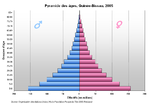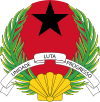Guinea-Bissau
Republic of Guinea-Bissau República da Guiné-Bissau (Portuguese) | |
|---|---|
| Motto: "Unidade, Luta, Progresso" (Portuguese) "Unity, Struggle, Progress" | |
| Anthem: Esta é a Nossa Pátria Bem Amada (Portuguese) This is Our Beloved Homeland | |
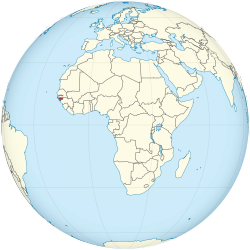 | |
| Capital and largest city | Bissau 11°52′N 15°36′W / 11.867°N 15.600°W |
| Official languages | Portuguese |
| Spoken languages | |
| Ethnic groups | |
| Religion (2010)[1] |
|
| Demonym(s) | Bissau-Guinean[2] |
| Government | Unitary semi-presidential republic |
| Umaro Sissoco Embaló | |
| Nuno Gomes Nabiam | |
| Legislature | National People's Assembly |
| Independence from Portugal | |
• Declared | 24 September 1973 |
• Recognized | 10 September 1974 |
| Area | |
• Total | 36,125 km2 (13,948 sq mi) (134th) |
• Water (%) | 22.4 |
| Population | |
• 2021 estimate | 2,060,721[3][4] (148th) |
• Density | 46.9/km2 (121.5/sq mi) (154th) |
| GDP (PPP) | 2018 estimate |
• Total | $3.391 billion[5] |
• Per capita | $1,951[5] |
| GDP (nominal) | 2018 estimate |
• Total | $1.480 billion[5] |
• Per capita | $851[5] |
| Gini (2002) | 35 medium inequality |
| HDI (2018) | low (178th) |
| Currency | West African CFA franc (XOF) |
| Time zone | UTC (GMT) |
| Drives on | right |
| Calling code | +245 |
| ISO 3166 code | GW |
| Internet TLD | .gw |
Guinea-Bissau (/ˌɡɪni bɪˈsaʊ/ ; Portuguese: Guiné-Bissau), officially the Republic of Guinea-Bissau (Portuguese: República da Guiné-Bissau [ʁɛˈpuβlikɐ ðɐ ɣiˈnɛ βiˈsaw]), is a country in West Africa that covers 36,125 square kilometres (13,948 sq mi) with an estimated population of 2,060,721.[3][4] It borders Senegal to the north and Guinea to the south-east.
Guinea-Bissau was once part of the kingdom of Kaabu, as well as part of the Mali Empire. Parts of this kingdom persisted until the 18th century, while a few others were under some rule by the Portuguese Empire since the 16th century. In the 19th century, it was colonised as Portuguese Guinea. Upon independence, declared in 1973 and recognised in 1974, the name of its capital, Bissau, was added to the country's name to prevent confusion with Guinea (formerly French Guinea). Guinea-Bissau has a history of political instability since independence, and only one elected president (José Mário Vaz) has successfully served a full five-year term.[7] The new president is (Umaro Sissoco Embalo) elected December 29 2019.
Only about 2% of the population speaks Portuguese, the official language, as a first language, and 33% speak it as a second language. However, Creole is the national language and also considered the language of unity. According to a 2012 study, 54% of the population speak Creole as a first language and about 52% speak it as a second language.[8] The remainder speak a variety of native African languages. There are diverse religions in Guinea-Bissau with no one religion having a majority. In 2008, the CIA World Factbook estimated that the population was about 45% Muslim, 22% Christian, 15% Animist, and 18% unspecified or other,[9] while a Pew Research survey in 2010 incidicates about 62% Christian, 38% Muslim, and 0% for traditional African religions and unaffiliated.[10] The country's per-capita gross domestic product is one of the lowest in the world.
Guinea-Bissau is a member of the United Nations, African Union, Economic Community of West African States, Organisation of Islamic Cooperation, Community of Portuguese Language Countries, La Francophonie, and the South Atlantic Peace and Cooperation Zone, and was a member of the now-defunct Latin Union.
History
Archeology has insufficiently explained the Guinea-Bissau pre-history. In 1000 CE, there were hunter-gatherers in the area, hundreds of thousands of years after they traversed the rest of Africa. This was shortly followed, in the archaeological record by agriculturists, using iron tools.[11]
Guinea-Bissau was once part of the kingdom of Kaabu, part of the Mali Empire in the 16th century. Parts of this kingdom persisted until the 18th century. Other parts of the territory in the current country were considered by the Portuguese as part of their empire.[12][better source needed] Portuguese Guinea was known as the Slave Coast, as it was a major area for the exportation of African slaves by Europeans to the western hemisphere.
Early reports of Europeans reaching this area include those of the Venetian Alvise Cadamosto's voyage of 1455, the 1479–1480 voyage by Flemish-French trader Eustache de la Fosse,[13] and Diogo Cão. In the 1480s this Portuguese explorer reached the Congo River and the lands of Bakongo, setting up the foundations of modern Angola, some 4200 km down the African coast from Guinea-Bissau.[14]
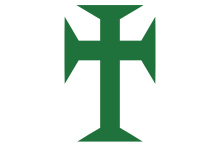
Although the rivers and coast of this area were among the first places colonized by the Portuguese, who set up trading posts in the 16th century, they did not explore the interior until the 19th century. The local African rulers in Guinea, some of whom prospered greatly from the slave trade, controlled the inland trade and did not allow the Europeans into the interior. They kept them in the fortified coastal settlements where the trading took place.[15] African communities that fought back against slave traders also distrusted European adventurers and would-be settlers. The Portuguese in Guinea were largely restricted to the ports of Bissau and Cacheu. A small number of European settlers established isolated farms along Bissau's inland rivers.[15]
For a brief period in the 1790s, the British tried to establish a rival foothold on an offshore island, at Bolama.[16] But by the 19th century the Portuguese were sufficiently secure in Bissau to regard the neighbouring coastline as their own special territory, also up north in part of present South Senegal.
An armed rebellion, begun in 1956 by the African Party for the Independence of Guinea and Cape Verde (PAIGC) under the leadership of Amílcar Cabral gradually consolidated its hold on the then Portuguese Guinea.[17] Unlike guerrilla movements in other Portuguese colonies, the PAIGC rapidly extended its military control over large portions of the territory, aided by the jungle-like terrain, its easily reached borderlines with neighbouring allies, and large quantities of arms from Cuba, China, the Soviet Union, and left-leaning African countries.[18] Cuba also agreed to supply artillery experts, doctors, and technicians.[19] The PAIGC even managed to acquire a significant anti-aircraft capability in order to defend itself against aerial attack. By 1973, the PAIGC was in control of many parts of Guinea, although the movement suffered a setback in January 1973 when Cabral was assassinated.[20]
Independence (1973)
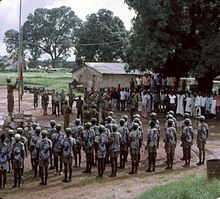
Independence was unilaterally declared on 24 September 1973, which is now celebrated as the country's Independence Day, a public holiday.[21] Recognition became universal following 25 April 1974 socialist-inspired military coup in Portugal, which overthrew Lisbon's Estado Novo regime.[22]
Luís Cabral, brother of Amílcar and co-founder of PAIGC, was appointed the first President of Guinea-Bissau. Following independence, the PAIGC killed thousands of local Guinean soldiers who had fought alongside the Portuguese Army against the guerrillas. Some escaped to settle in Portugal or other African nations.[23] One of the massacres occurred in the town of Bissorã. In 1980 the PAIGC acknowledged in its newspaper Nó Pintcha (dated 29 November 1980) that many Guinean soldiers had been executed and buried in unmarked collective graves in the woods of Cumerá, Portogole, and Mansabá.
The country was controlled by a revolutionary council until 1984. The first multi-party elections were held in 1994. An army uprising in May 1998 led to the Guinea-Bissau Civil War and the president's ousting in June 1999.[24] Elections were held again in 2000, and Kumba Ialá was elected president.[25]
In September 2003, a military coup was conducted. The military arrested Ialá on the charge of being "unable to solve the problems".[26] After being delayed several times, legislative elections were held in March 2004. A mutiny of military factions in October 2004 resulted in the death of the head of the armed forces and caused widespread unrest.
Vieira years
In June 2005, presidential elections were held for the first time since the coup that deposed Ialá. Ialá returned as the candidate for the PRS, claiming to be the legitimate president of the country, but the election was won by former president João Bernardo Vieira, deposed in the 1999 coup. Vieira beat Malam Bacai Sanhá in a run-off election. Sanhá initially refused to concede, claiming that tampering and electoral fraud occurred in two constituencies including the capital, Bissau.[27]
Despite reports of arms entering the country prior to the election and some "disturbances during campaigning", including attacks on government offices by unidentified gunmen, foreign election monitors described the 2005 election overall as "calm and organized".[28]
Three years later, PAIGC won a strong parliamentary majority, with 67 of 100 seats, in the parliamentary election held in November 2008.[29] In November 2008, President Vieira's official residence was attacked by members of the armed forces, killing a guard but leaving the president unharmed.[30]
On 2 March 2009, however, Vieira was assassinated by what preliminary reports indicated to be a group of soldiers avenging the death of the head of joint chiefs of staff, General Batista Tagme Na Wai, who had been killed in an explosion the day before.[31] Vieira's death did not trigger widespread violence, but there were signs of turmoil in the country, according to the advocacy group Swisspeace.[32] Military leaders in the country pledged to respect the constitutional order of succession. National Assembly Speaker Raimundo Pereira was appointed as an interim president until a nationwide election on 28 June 2009.[33] It was won by Malam Bacai Sanhá of the PAIGC, against Kumba Ialá as the presidential candidate of the PRS.
On 9 January 2012, President Sanhá died of complications from diabetes, and Pereira was again appointed as an interim president. On the evening of 12 April 2012, members of the country's military staged a coup d'état and arrested the interim president and a leading presidential candidate.[34] Former vice chief of staff, General Mamadu Ture Kuruma, assumed control of the country in the transitional period and started negotiations with opposition parties.[35][36]
Politics


Guinea-Bissau is a republic. In the past, the government had been highly centralized. Multi-party governance was not established until mid-1991. The president is the head of state and the prime minister is the head of government. Since 1974, no president had successfully served a full five-year term, until recently when Jose Mario Vaz ended his five-year term on June 24, 2019.
At the legislative level, a unicameral Assembleia Nacional Popular (National People's Assembly) is made up of 100 members. They are popularly elected from multi-member constituencies to serve a four-year term. The judicial system is headed by a Tribunal Supremo da Justiça (Supreme Court), made up of nine justices appointed by the president; they serve at the pleasure of the president.[37]
The two main political parties are the PAIGC (African Party for the Independence of Guinea and Cape Verde) and the PRS (Party for Social Renewal). There are more than 20 minor parties.[38]
Foreign relations
Guinea-Bissau follows a nonaligned foreign policy and seeks friendly and cooperative relations with a wide variety of states and organisations.
Guinea-Bissau is a founding member state of the Community of Portuguese Language Countries (CPLP), also known as the Lusophone Commonwealth, and international organisation and political association of Lusophone nations across four continents, where Portuguese is an official language.
Military
A 2008 estimate put the size of the Guinea-Bissau Armed Forces at around 4,000 personnel.
In 2018, Guinea-Bissau signed the UN treaty on the Prohibition of Nuclear Weapons.[39]
Administrative divisions
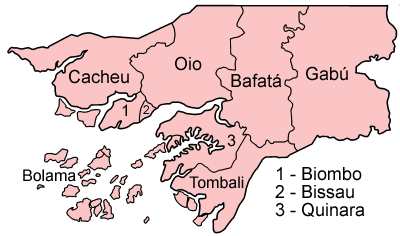
Guinea-Bissau is divided into eight regions (regiões) and one autonomous sector (sector autónomo). These, in turn, are subdivided into 37 Sectors. The regions are:
- ^ Autonomous sector.
Geography

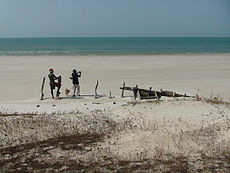
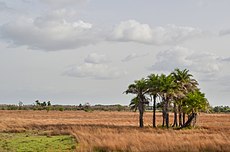
Guinea-Bissau is bordered by Senegal to the north and Guinea to the south and east, with the Atlantic Ocean to its west. It lies mostly between latitudes 11° and 13°N (a small area is south of 11°), and longitudes 13° and 17°W.
At 36,125 square kilometres (13,948 sq mi), the country is larger in size than Taiwan or Belgium. The highest point is 300 metres (984 ft). Its terrain is mostly low coastal plains with swamps of the Guinean mangroves rising to the Guinean forest-savanna mosaic in the east.[40] Its monsoon-like rainy season alternates with periods of hot, dry harmattan winds blowing from the Sahara. The Bijagos Archipelago lies off of the mainland.[41]
Climate
Guinea-Bissau is warm all year round with mild temperature fluctuations; it averages 26.3 °C (79.3 °F). The average rainfall for Bissau is 2,024 millimetres (79.7 in), although this is almost entirely accounted for during the rainy season which falls between June and September/October. From December through April, the country experiences drought.[42]
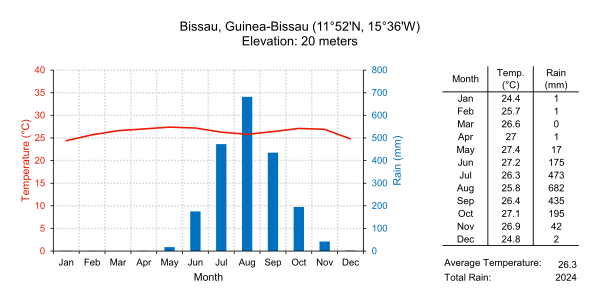
Environmental problems
Severe environmental problems include deforestation, soil erosion, overgrazing, and overfishing.[40]
Economy
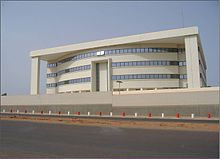

Guinea-Bissau's GDP per capita is one of the lowest in the world, and its Human Development Index is one of the lowest on earth. More than two-thirds of the population lives below the poverty line.[43] The economy depends mainly on agriculture; fish, cashew nuts, and ground nuts are its major exports.
A long period of political instability has resulted in depressed economic activity, deteriorating social conditions, and increased macroeconomic imbalances. It takes longer on average to register a new business in Guinea-Bissau (233 days or about 33 weeks) than in any other country in the world except Suriname.[44]
Guinea-Bissau has started to show some economic advances after a pact of stability was signed by the main political parties of the country, leading to an IMF-backed structural reform program.[45] The key challenges for the country in the period ahead are to achieve fiscal discipline, rebuild public administration, improve the economic climate for private investment, and promote economic diversification. After the country became independent from Portugal in 1974 due to the Portuguese Colonial War and the Carnation Revolution, the rapid exodus of the Portuguese civilian, military, and political authorities resulted in considerable damage to the country's economic infrastructure, social order, and standard of living.
After several years of economic downturn and political instability, in 1997, Guinea-Bissau entered the CFA franc monetary system, bringing about some internal monetary stability.[46] The civil war that took place in 1998 and 1999, and a military coup in September 2003 again disrupted economic activity, leaving a substantial part of the economic and social infrastructure in ruins and intensifying the already widespread poverty. Following the parliamentary elections in March 2004 and presidential elections in July 2005, the country is trying to recover from the long period of instability, despite a still-fragile political situation.
Beginning around 2005, drug traffickers based in Latin America began to use Guinea-Bissau, along with several neighbouring West African nations, as a transshipment point to Europe for cocaine.[47] The nation was described by a United Nations official as being at risk for becoming a "narco-state".[48] The government and the military have done little to stop drug trafficking, which increased after the 2012 coup d'état.[49] The government of Guinea-Bissau continues to be ravaged by illegal drug distribution, according to The Week magazine. [50] Guinea-Bissau is a member of the Organisation for the Harmonisation of Business Law in Africa (OHADA).[51]
Society
Demographics
According to the 2022 revision of the World Population Prospects[3][4], Guinea-Bissau's population was 2,060,721 in 2021, compared to 518,000 in 1950. The proportion of the population below the age of 15 in 2010 was 41.3%, 55.4% were aged between 15 and 65 years of age, while 3.3% were aged 65 years or older.[52]
Ethnic groups

The population of Guinea-Bissau is ethnically diverse and has many distinct languages, customs, and social structures.
Bissau-Guineans can be divided into the following ethnic groups:
- Fula and the Mandinka-speaking people, who comprise the largest portion of the population and are concentrated in the north and northeast;
- Balanta and Papel people, who live in the southern coastal regions; and
- Manjaco and Mancanha, who occupy the central and northern coastal areas.
Most of the remainder are mestiços of mixed Portuguese and African descent.
Portuguese natives comprise a very small percentage of Bissau-Guineans. After Guinea-Bissau gained independence, most of the Portuguese nationals left the country. The country has a tiny Chinese population.[54] These include traders and merchants of mixed Portuguese and Chinese ancestry from the former Asian Portuguese colony of Macau.
Major cities
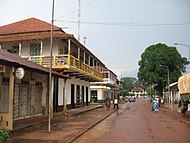
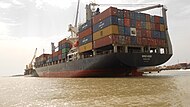
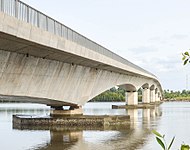
Main cities in Guinea-Bissau include:[55]
| Rank | City | Population | |
|---|---|---|---|
| 2015 estimate | Region | ||
| 1 | Bissau | 492,004 | Bissau |
| 2 | Gabú | 48,670 | Gabú |
| 3 | Bafatá | 37,985 | Bafatá |
| 4 | Bissorã | 29,468 | Oio |
| 5 | Bolama | 16,216 | Bolama |
| 6 | Cacheu | 14,320 | Cacheu |
| 7 | Bubaque | 12,922 | Bolama |
| 8 | Catió | 11,498 | Tombali |
| 9 | Mansôa | 9,198 | Oio |
| 10 | Buba | 8,993 | Quinara |
Languages
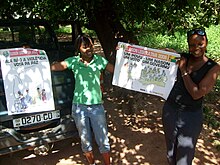
Despite being a small country Guinea-Bissau has several ethnic groups which are very distinct from each other, with their own cultures and languages. This is due to Guinea-Bissau being a refugee and migration territory within Africa. Colonisation and miscegenation brought Portuguese and the Portuguese creole known as Kriol or crioulo.[56]
Although the only official language of Guinea-Bissau since independence, Standard Portuguese is spoken mostly as a second language, with few native speakers and its use is often confined to the intellectual and political elites. It is the language of government and national communication as a legacy of colonial rule. Schooling from the primary to tertiary levels is conducted in Portuguese, although only 67% of children have access to any formal education. Data suggests that the number of Portuguese speakers ranges from 11 to 15%. In the latest census (2009) 27.1% of the population claimed to speak non-creole Portuguese (46.3% of city dwellers and 14.7% of the rural population, respectively).[57] Portuguese creole is spoken by 44% of the population and is effectively the lingua franca among distinct groups for most of the population. Creole's usage is still expanding, and it is understood by the vast majority of the population. However, decreolisation processes are occurring, due to undergoing interference from Standard Portuguese and the creole forms a continuum of varieties with the standard language, the most distant are basilects and the closer ones, acrolects. A post-creole continuum exists in Guinea-Bissau and crioulo 'leve' ('soft' creole) variety being closer to the Portuguese-language norm.[56]
The remaining rural population speaks a variety of native African languages unique to each ethnicity: Fula (16%), Balanta (14%), Mandinka (7%), Manjak (5%), Papel (3%), Felupe (1%), Beafada (0.7%), Bijagó (0.3%), and Nalu (0.1%), which form the ethnic African languages spoken by the population.[56][58] Most Portuguese and Mestiços speakers also have one of the African languages and Kriol as additional languages. Ethnic African languages are not discouraged, in any situation, despite their lower prestige. These languages are the link between individuals of the same ethnic background and daily used in villages, between neighbours or friends, traditional and religious ceremonies, and also used in contact between the urban and rural populations. However, none of these languages are dominant in Guinea-Bissau.[56]
It should also be noted that French is taught as a foreign language in schools, because Guinea-Bissau is surrounded by French-speaking nations. Guinea-Bissau is a full member of the Francophonie.[59]
Religion

There are conflicting reports of religious demographics. The CIA World Factbook has a 2008 estimate of 45.1% Muslim, 22.1% Christian, 14.9% animist, 2% none, and 15.9% unspecified.[9] In 2010, a Pew Research survey found that the primary affiliation of the population is 62% Christian and 38% Muslim, with 0% for other affiliations.[10][60] A 2015 Pew-Templeton study claims a different distribution in 2010, consisting of 45.1% Muslim, 30.9% folk religions, 19.7% Christians, and 4.3% unaffiliated.[61]
According to another Pew report, concerning religious identity among Muslims, it was determined that in Guinea-Bissau there is no prevailing sectarian identity. Under this same category were other Sub-Saharan countries like Tanzania, Uganda, Liberia, Nigeria and Cameroon. Other nations around the world claimed to be either predominantly Just Muslim, Mix of Sunni and Shia, or predominantly Sunni (pg. 30).[62] This Pew research also stated that countries in this specific study that declared to not have any clear dominant sectarian identity were mostly concentrated in Sub-Saharan Africa.[63] Another Pew report, The Future of World Religions, predicts that from 2010 to 2050 Islam will increase its percent of the population in Guinea-Bissau.[61]
Many residents practice syncretic forms of Islamic and Christian faiths, combining their practices with traditional African beliefs.[40][64] Muslims dominate the north and east, while Christians dominate the south and coastal regions. The Roman Catholic Church claims most of the Christian community.[65]
Health
Education
Education is compulsory from the age of 7 to 13. Pre-school education for children between three and six years of age is optional and in its early stages. There are five levels of education: pre-school, elemental and complementary basic education, general and complementary secondary education, general secondary education, technical and professional teaching, and higher education (university and non-universities). Basic education is under reform, and now forms a single cycle, comprising 6 years of education. Secondary education is widely available and there are two cycles (7th to 9th classe and 10th to 11th classe). Professional education in public institutions is nonoperational, however private school offerings opened, including the Centro de Formação São João Bosco (since 2004) and the Centro de Formação Luís Inácio Lula da Silva (since 2011).[56]
Higher education is limited and most prefer to be educated abroad, with students preferring to enroll in Portugal.[56] A number of universities, to which an institutionally autonomous Faculty of Law as well as a Faculty of Medicine[66]
Child labor is very common.[67] The enrollment of boys is higher than that of girls. In 1998, the gross primary enrollment rate was 53.5%, with higher enrollment ratio for males (67.7%) compared to females (40%).[67]
Non-formal education is centered on community schools and the teaching of adults.[56] In 2011, the literacy rate was estimated at 55.3% (68.9% male, and 42.1% female).[68]
Conflicts
Usually, the many different ethnic groups in Guinea-Bissau coexist peacefully, but when conflicts do erupt, they tend to revolve around access to land.[69]
Culture


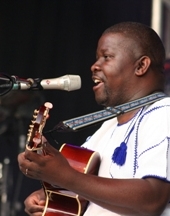
Media
Music
The music of Guinea-Bissau is usually associated with the polyrhythmic gumbe genre, the country's primary musical export. However, civil unrest and other factors have combined over the years to keep gumbe, and other genres, out of mainstream audiences, even in generally syncretist African countries.[70]
The cabasa is the primary musical instrument of Guinea-Bissau,[71] and is used in extremely swift and rhythmically complex dance music. Lyrics are almost always in Guinea-Bissau Creole, a Portuguese-based creole language, and are often humorous and topical, revolving around current events and controversies.[72]
The word gumbe is sometimes used generically, to refer to any music of the country, although it most specifically refers to a unique style that fuses about ten of the country's folk music traditions.[73] Tina and tinga are other popular genres, while extent folk traditions include ceremonial music used in funerals, initiations, and other rituals, as well as Balanta brosca and kussundé, Mandinga djambadon, and the kundere sound of the Bissagos Islands.[74]
Cuisine
Rice is a staple in the diet of residents near the coast and millet a staple in the interior. Fruits and vegetables are commonly eaten along with cereal grains. The Portuguese encouraged peanut production. Vigna subterranea (Bambara groundnut) and Macrotyloma geocarpum (Hausa groundnut) are also grown. Black-eyed peas are also part of the diet. Palm oil is harvested.
Common dishes include soups and stews. Common ingredients include yams, sweet potato, cassava, onion, tomato, and plantain. Spices, peppers, and chilis are used in cooking, including Aframomum melegueta seeds (Guinea pepper).
Film
Flora Gomes is an internationally renowned film director; his most famous film is Nha Fala (Template:Lang-en).[75] Gomes's Mortu Nega (Death Denied) (1988)[76] was the first fiction film and the second feature film ever made in Guinea-Bissau. (The first feature film was N’tturudu, by director Umban u’Kest in 1987.) At FESPACO 1989, Mortu Nega won the prestigious Oumarou Ganda Prize. In 1992, Gomes directed Udju Azul di Yonta,[77] which was screened in the Un Certain Regard section at the 1992 Cannes Film Festival.[78] Gomes has also served on the boards of many Africa-centric film festivals.[79] The actress Babetida Sadjo was born in Bafatá, Guinea-Bissau.[80]
Sports
Football is the most popular sport in Guinea-Bissau. The Guinea-Bissau national football team is controlled by the Federação de Futebol da Guiné-Bissau. They are a member of the Confederation of African Football (CAF) and FIFA. Other football clubs include Desportivo Quelele, FC Catacumba, FC Catacumba São Domingos, FC Cupelaoo Gabu, FC Djaraf, FC Prabis, and FC Babaque.
See also
References
- ^ http://www.globalreligiousfutures.org/countries/guinea-bissau/religious_demography#/?affiliations_religion_id=0&affiliations_year=2010
- ^ "Guinea-Bissau" – Field Listing: Nationality. Archived 26 June 2015 at the Wayback Machine The World Factbook 2013–14. Washington, DC: Central Intelligence Agency, 2013. Retrieved 15 July 2015.
- ^ a b c "World Population Prospects 2022". United Nations Department of Economic and Social Affairs, Population Division. Retrieved 17 July 2022.
- ^ a b c "World Population Prospects 2022: Demographic indicators by region, subregion and country, annually for 1950-2100" (XSLX) ("Total Population, as of 1 July (thousands)"). United Nations Department of Economic and Social Affairs, Population Division. Retrieved 17 July 2022.
- ^ a b c d "Guinea-Bissau". International Monetary Fund. Archived from the original on 11 November 2018. Retrieved 18 October 2018.
- ^ "Human Development Report 2019". United Nations Development Programme. 10 December 2019. Retrieved 10 December 2019.
- ^ "Guinea-Bissau – History". Encyclopedia Britannica. Retrieved 27 May 2020.
- ^ Handem, Myrna (2015). Portuguese, Creole, or Both: The Problematic of Language Choice in the Republic of Guinea-Bissau. The Social, Political and Economic Implications of Language Choice (Ph. D. thesis). Howard University.
- ^ a b c "Africa: Guinea-Bissau". The World Factbook. Central Intelligence Agency. Retrieved 1 January 2020.
- ^ a b "Chapter 1: Religious Affiliation". Tolerance and Tension: Islam and Christianity in Sub-Saharan Africa (Report). Pew Research Center. 15 April 2010.
- ^ "Early history". Encyclopedia Britannica. Retrieved 24 May 2020.
- ^ "Empire of Kaabu, West Africa". Access Gambia. Archived from the original on 30 June 2013. Retrieved 22 June 2013..
- ^ De La Fosse, Eustache (1992). Voyage d'Eustache Delafosse sur la côte de Guinée, au Portugal et en Espagne: 1479–1481. Paris: éditions Chandeigne. ISBN 978-2-906462-03-8. Archived from the original on 2 January 2014. Retrieved 19 December 2012.
- ^ "Diogo Cão". win.tue.nl. Archived from the original on 8 February 2007. Retrieved 7 February 2006.
- ^ a b US Department of State. "A Brief History of Guinea-Bissau – Part 1". African History at About.com. Archived from the original on 5 January 2013. Retrieved 22 June 2013.
- ^ "British Library – Endangered Archive Programme (EAP)". inep-bissau.org. 18 March 1921. Retrieved 22 June 2013.
{{cite web}}: Check|archive-url=value (help) - ^ Cabral, Amilcar (1966). "The Weapon of Theory: Address delivered to the first Tricontinental Conference of the Peoples of Asia, Africa and Latin America held in Havana in January, 1966". Marxists.org. Archived from the original on 16 October 2012. Retrieved 22 June 2013.
- ^ "The PAIC Programme Appendix". Marxists.org. Archived from the original on 30 January 2013. Retrieved 22 June 2013.
- ^ El Tahri, Jihan (2007). Cuba! Africa! Revolution!. BBC Television. Event occurs at 50:00–60:00. Archived from the original on 10 December 2016. Retrieved 2 May 2007.
- ^ Brittain, Victoria (17 January 2011). "Africa: a continent drenched in the blood of revolutionary heroes". The Guardian. London. Archived from the original on 17 January 2017. Retrieved 14 December 2016.
- ^ Benzinho, Joana; Rosa, Marta (December 2015). Discovering Guinea-Bissau (PDF). NGO afectos com Letra. p. 29. ISBN 978-989-20-6315-7. Retrieved 20 September 2019.
- ^ "Embassy of The Republic of Guinea-Bissau – Country Profile". Diplomatic & Consular Yearbook Online. 12 April 2012. Archived from the original on 8 February 2013. Retrieved 22 June 2013.
- ^ Guiné-Bissau: Morreu Luís Cabral, primeiro presidente do país Archived 3 May 2014 at the Wayback Machine. Expresso.sapo.pt (30 May 2009). Retrieved 22 June 2013.
- ^ Uppsala Conflict Data Program Conflict Encyclopedia, Guinea Bissau: government, in depth, Negotiations, Veira's surrender and the end of the conflict Archived 31 December 2013 at the Wayback Machine, viewed 12 July 2013,
- ^ Guinea-Bissau's Kumba Yala: from crisis to crisis Archived 16 July 2012 at the Wayback Machine. Afrol.com. Retrieved 22 June 2013.
- ^ Smith, Brian (27 September 2003) "US and UN give tacit backing to Guinea Bissau coup" Archived 27 October 2012 at the Wayback Machine, Wsws.org, September 2003. Retrieved 22 June 2013
- ^ GUINEA-BISSAU: Vieira officially declared president Archived 25 August 2012 at the Wayback Machine. irinnews.org (10 August 2005).
- ^ "Army man wins G Bissau election". BBC News. London. 28 July 2005. Archived from the original on 27 June 2006. Retrieved 5 January 2010.
- ^ Guinea Bissau vote goes smooth amid hopes for stability. AFP via Google.com (16 November 2008). Retrieved 22 June 2013.
- ^ Balde, Assimo (24 November 2008). "Coup attempt fails in Guinea-Bissau". London: The Independent UK independent.co.uk. Archived from the original on 15 May 2011. Retrieved 28 June 2010.
- ^ "Soldiers kill fleeing President". Archived from the original on 8 March 2009. Retrieved 2 March 2009.
{{cite web}}: CS1 maint: bot: original URL status unknown (link). news.com.au (2 March 2009). - ^ Elections, Guinea-Bissau (27 May 2009). "On the Radio Waves in Guinea-Bissau". swisspeace. Archived from the original on 8 December 2009. Retrieved 7 February 2010.
- ^ "Já foi escolhida a data para a realização das eleições presidenciais entecipadas". Bissaudigital.com. 1 April 2009. Archived from the original on 21 January 2012. Retrieved 26 June 2010.
- ^ "Tiny Guinea-Bissau becomes latest West African nation hit by coup". Bissau. 12 April 2012. Archived from the original on 13 April 2012. Retrieved 14 April 2012.
- ^ Embalo, Allen Yero (14 April 2012). "Fears grow for members of toppled G.Bissau government". Agence France-Presse. Archived from the original on 3 March 2014. Retrieved 2 May 2012.
{{cite news}}: CS1 maint: bot: original URL status unknown (link) - ^ "Guinea-Bissau opposition vows to reach deal with junta | Radio Netherlands Worldwide". Rnw.nl. 15 April 2012. Archived from the original on 12 October 2014. Retrieved 2 May 2012.
- ^ Guinea-Bissau Supreme Court Archived 23 January 2012 at the Wayback Machine. Stj.pt. Retrieved 22 June 2013.
- ^ Guinea-Bissau Political Parties Archived 9 May 2013 at the Wayback Machine. Nationsencyclopedia.com. Retrieved 22 June 2013.
- ^ "Chapter XXVI: Disarmament – No. 9 Treaty on the Prohibition of Nuclear Weapons". United Nations Treaty Collection. 7 July 2017.
- ^ a b c "Guinea-Bissau" Archived 28 December 2010 at the Wayback Machine, CIA the World Factbook, Cia.gov. Retrieved 5 February 2012.
- ^ Nossiter, Adam (4 November 2009) "Bijagós, a Tranquil Haven in a Troubled Land", The New York Times, 8 November 2009
- ^ Guinea-Bissau Climate Archived 9 May 2013 at the Wayback Machine. Nationsencyclopedia.com. Retrieved 22 June 2013.
- ^ World Bank profile Archived 11 November 2012 at the Wayback Machine. World Bank.org (31 May 2013). Retrieved 22 June 2013.
- ^ The Economist (2007). Pocket World in Figures (2008 ed.). London: Profile Books. ISBN 978-1861978448.
- ^ Guinea-Bissau and the IMF Archived 16 October 2012 at the Wayback Machine. Imf.org (13 May 2013). Retrieved 22 June 2013.
- ^ CFA Franc and Guinea-Bissau Archived 26 October 2012 at the Wayback Machine. Uemoa.int. Retrieved 22 June 2013.
- ^ Guinea-Bissau:A narco-state? Archived 29 October 2012 at the Wayback Machine. Time. (29 October 2009). Retrieved 22 June 2013.
- ^ Sullivan, Kevin (25 May 2008). "Route of Evil: How a tiny West African nation became a key smuggling hub for Colombian cocaine, and the price it is paying". The Washington Post. Archived from the original on 25 May 2017. Retrieved 27 August 2017.
- ^ "Guinea-Bissau drug trade 'rises since coup'". BBC News. London. 31 July 2012. Archived from the original on 27 October 2012. Retrieved 5 October 2012.
- ^ "Guinea-Bissau, Africa's most famous narco-state, goes to the polls". The Economist. 2 November 2019.
- ^ "OHADA.com • The business law portal in Africa". OHADA.com (in French). Paul Bayzelon. Archived from the original on 26 March 2009. Retrieved 10 January 2018.
- ^ a b "Population Division of the Department of Economic and Social Affairs of the United Nations Secretariat, World Population Prospects: The 2010 Revision". Esa.un.org. Archived from the original on 6 May 2011. Retrieved 20 January 2017.
- ^ a b "Recenseamento Geral da População e Habitação 2009 Características Socioculturais" (PDF). Instituto Nacional de Estatística Guiné-Bissau. Retrieved 28 March 2020.
- ^ China-Guinea-Bissau Archived 11 October 2012 at the Wayback Machine. China.org.cn. Retrieved 22 June 2013.
- ^ "Guinea-Bissau: Regions, Cities & Urban Localities – Population Statistics in Maps and Charts". citypopulation.de. Archived from the original on 2 December 2017. Retrieved 1 December 2017.
- ^ a b c d e f g Barbosa, José (2015). Língua e desenvolvimento: O caso da Guiné-Bissau [Language and Development: The case of Guinea-Bissau] (PDF) (Master's thesis) (in Portuguese). Universidade de Lisboa. Archived (PDF) from the original on 9 August 2017. Retrieved 10 May 2017.
- ^ Mendes, Etoal (2018). Experiências de ensino bilíngue em Bubaque, Guiné-Bissau: línguas e saberes locais na educação escolar [Bilingual teaching experiences in Bubaque, Guinea-Bissau: languages and local knowledge in school education] (PDF) (Master's thesis) (in Portuguese). Universidade Federal do Rio Grande do Sul. hdl:10183/178453.
- ^ "Crioulo, Upper Guinea". Ethnologue. Retrieved 22 June 2013.
- ^ "Welcome to the International Organisation of La Francophonie's Official Website". Francophonie.org. Archived from the original on 1 April 2014. Retrieved 22 June 2013.
- ^ Tolerance and Tension: Islam and Christianity in Sub-Saharan Africa (PDF) (Report). Pew Forum on Religious & Public life. April 2010. p. 20. Archived from the original (PDF) on 30 April 2018. Retrieved 25 April 2018.
- ^ a b "Religions in Guinea Bissau". Global Religious Futures. Pew-Templeton.
- ^ The World’s Muslims: Unity and Diversity (PDF) (Report). Pew Research Center. 9 August 2012. pp. 28–30. Archived from the original (PDF) on 24 October 2012.
- ^ The World’s Muslims: Unity and Diversity (PDF) (Report). Pew Research Center. 9 August 2012. p. 29. Archived from the original (PDF) on 24 October 2012.
- ^ "Guinea-Bissau" Archived 16 April 2009 at the Wayback Machine, Encyclopædia Britannica
- ^ Guinea-Bissau: Society & Culture Complete Report an All-Inclusive Profile Combining All of Our Society and Culture Reports (2nd ed.). Petaluma: World Trade Press. 2010. p. 7. ISBN 978-1607804666.
- ^ The latter is maintained by Cuba and functions in different cities.
- ^ a b "Guinea-Bissau". 2001 Findings on the Worst Forms of Child Labor. Bureau of International Labor Affairs, U.S. Department of Labor (2002). This article incorporates text from this source, which is in the public domain.
- ^ "Field Listing :: Literacy". The World Factbook. Archived from the original on 24 November 2016. Retrieved 15 October 2014.
- ^ "Theatre sheds light on conflicts". D+C, development and cooperation. 23 June 2017. Archived from the original on 15 August 2017. Retrieved 15 August 2017.
{{cite news}}: Unknown parameter|authors=ignored (help) - ^ Lobeck, Katharina (21 May 2003) Manecas Costa Paraiso di Gumbe Review Archived 24 February 2018 at the Wayback Machine. BBC. Retrieved 22 June 2013.
- ^ The Kora. Freewebs.com. Retrieved 22 June 2013.
- ^ Radio Africa: Guinea Bissau vinyl discography Archived 25 October 2012 at the Wayback Machine. Radioafrica.com.au. Retrieved 22 June 2013.
- ^ "Radio Gumbe". Archived from the original on 28 September 2018.
- ^ Music of Guinea-Bissau Archived 5 June 2013 at the Wayback Machine. Ccas11bijagos.pbworks.com. Retrieved 22 June 2013.
- ^ "Nha Fala/My Voice". spot.pcc.edu. 2002. Archived from the original on 8 February 2013.
- ^ Mortu Nega Archived 18 December 2008 at the Wayback Machine. California Newsreel. Newsreel.org. Retrieved 22 June 2013.
- ^ Udju Azul di Yonta Archived 5 July 2009 at the Wayback Machine. California Newsreel. Newsreel.org. Retrieved 22 June 2013.
- ^ "Festival de Cannes: Udju Azul di Yonta". Festival de Cannes. Archived from the original on 20 October 2014. Retrieved 16 August 2009.
{{cite web}}: CS1 maint: bot: original URL status unknown (link) - ^ Flora Gomes The Two Faces of War: National Liberation in Guinea-Bissau Archived 8 February 2013 at the Wayback Machine. Watsoninstitute.org (25 October 2007). Retrieved 22 June 2013.
- ^ de Lamalle, Patrick (19 October 2018). "Babetida Sadjo, est-ce que vous l'avez vu ?". RTBF (in French). Retrieved 12 January 2019.
![]() This article incorporates public domain material from The World Factbook. CIA.
This article incorporates public domain material from The World Factbook. CIA.
Further reading
- Abdel Malek, K.,"Le processus d'accès à l'indépendance de la Guinée-Bissau", In : Bulletin de l'Association des Anciens Elèves de l'Institut National de Langues et de Cultures Orientales, N°1, Avril 1998. – pp. 53–60
- Forrest, Joshua B., Lineages of State Fragility. Rural Civil Society in Guinea-Bissau (Ohio University Press/James Currey Ltd., 2003)
- Galli, Rosemary E, Guinea Bissau: Politics, Economics and Society, (Pinter Pub Ltd., 1987)
- Lobban Jr., Richard Andrew and Mendy, Peter Karibe, Historical Dictionary of the Republic of Guinea-Bissau, third edition (Scarecrow Press, 1997)
- Vigh, Henrik, Navigating Terrains of War: Youth And Soldiering in Guinea-Bissau, (Berghahn Books, 2006)
External links
- Link collection related to Guinea-Bissau on bolama.net
- Country Profile from BBC News
- "Guinea-Bissau". The World Factbook (2024 ed.). Central Intelligence Agency.
- Guinea-Bissau from UCB Libraries GovPubs
- Guinea-Bissau at Encyclopædia Britannica
- Template:Curlie
 Wikimedia Atlas of Guinea-Bissau
Wikimedia Atlas of Guinea-Bissau- Key Development Forecasts for Guinea-Bissau from International Futures
- Government
- Official website
- Constitution of the Republic of Guinea-Bissau
- Guinea-Bissau: Prime Minister’s fate unknown after apparent military coup – West Africa – Portuguese American Journal
- Guinea-Bissau Holds First Post-Coup Election
- Trade
- News media
- Tourism
 Guinea-Bissau travel guide from Wikivoyage
Guinea-Bissau travel guide from Wikivoyage- Guinea-Bissau Turismo – RIOS AND LAGOONS
- Health
- The State of the World's Midwifery – Guinea-Bissau Country Profile
- GIS information
- Master Thesis about the developing Geographical Information for Guinea-Bissau
- Guinea-Bissau
- Economic Community of West African States
- Former Portuguese colonies
- Least developed countries
- Member states of the Organisation internationale de la Francophonie
- Member states of the African Union
- Member states of the Community of Portuguese Language Countries
- Member states of the Organisation of Islamic Cooperation
- Member states of the United Nations
- Portuguese-speaking countries and territories
- Republics
- States and territories established in 1974
- West African countries
- Small Island Developing States
- 1974 establishments in Guinea-Bissau
- Countries in Africa




